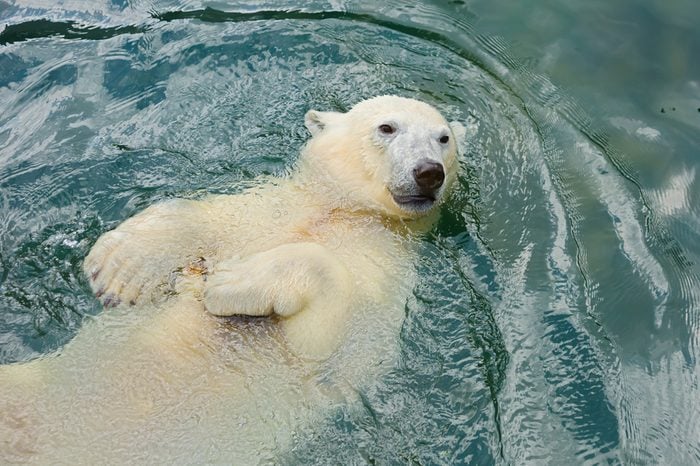
Polar bears are classified as marine mammals
Yep, like dolphins, sea lions, and manatees—and unlike any other species of bear—polar bears are considered marine mammals, according to the World Wildlife Fund. “They rely on the ocean or marine ecosystem for everything they do,” says Kristin Laidre, PhD, a marine biologist at the University of Washington and a member of the International Union for Conservation of Nature’s Polar Bear Specialist Group. The animals spend most of their lives on Arctic sea ice, where they hunt for seals, and their Latin name, Ursus maritimus, translates to “sea bear.”
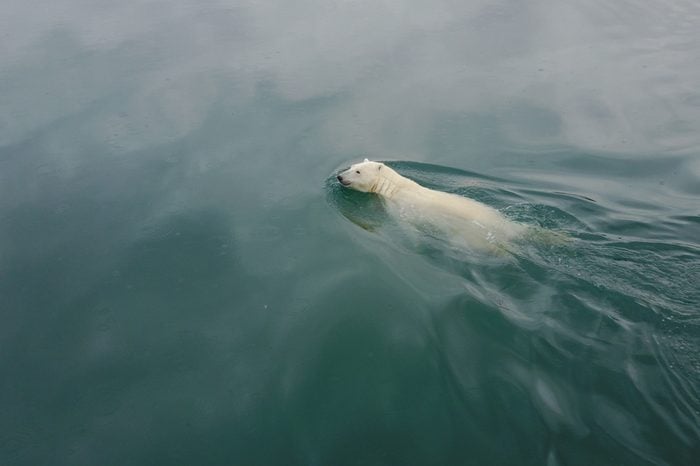
They can swim for days
“Polar bears are great swimmers,” says Eric Regehr, PhD, Laidre’s husband, who is also a marine biologist at the University of Washington and a member of the IUCN Polar Bear Specialist Group. “The maximum distance recorded is several hundred miles over the course of multiple days.” However, bears often try to avoid long-distance swimming because it’s so demanding, he adds. In fact, a study published in New Scientist finds that polar bears have metabolic rates more than 1.6 times higher than what researchers had previously assumed; the farther they have to travel to find food, the less likely they are to be able to replace the calories they burn traveling. Don’t miss these 12 adorable polar bear pictures.
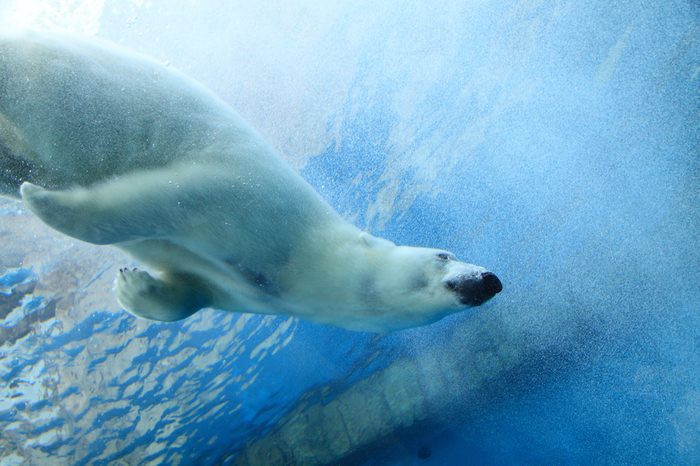
And they swim fast!
Polar bears can swim more than six miles per hour, according to SeaWorld. That’s significantly faster than most humans—it matches Michael Phelps’s fastest recorded swimming speed, according to ESPN. What’s more, polar bears really only use their big front paws to swim—like kids doing a doggy paddle—while their back feet act like a rudder to help them steer.
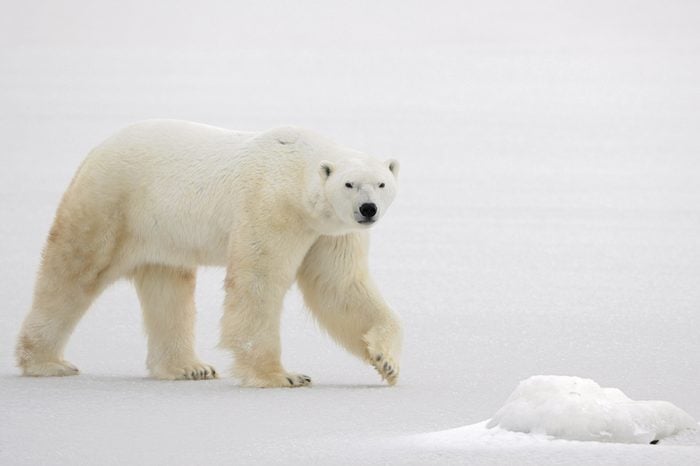
Their fur has special adaptations
For one thing, the color makes it easier to hunt in the Arctic: “Polar bear fur helps camouflage them on the sea ice,” Laidre says. The thick coat consists of a dense layer of fur close to the skin and an outer layer of longer strands, according to the nonprofit advocacy group Polar Bears International. The fur provides such good insulation that the animals can actually overheat if they run too far. Learn about these animals that can only be found one place in the world.
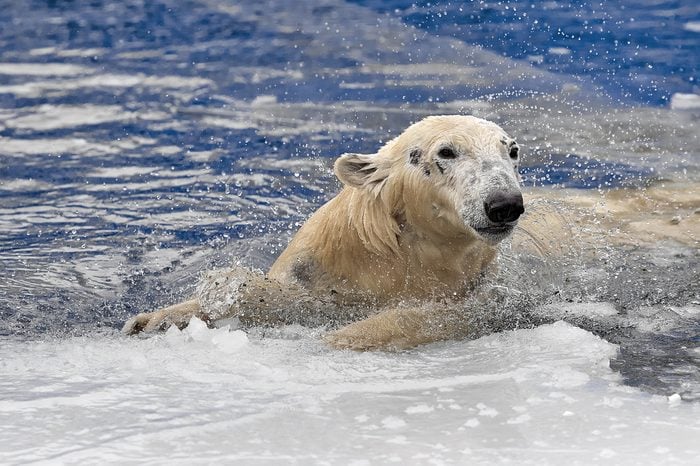
Polar bears rely on their fat to keep them warm
Wet fur is not nearly as insulating as dry fur, so when polar bears swim, a layer of fat just below their skin helps them retain their body heat. According to SeaWorld, that fat layer can be as much as 4.5 inches thick. (Surprisingly, polar bear skin is actually black.)
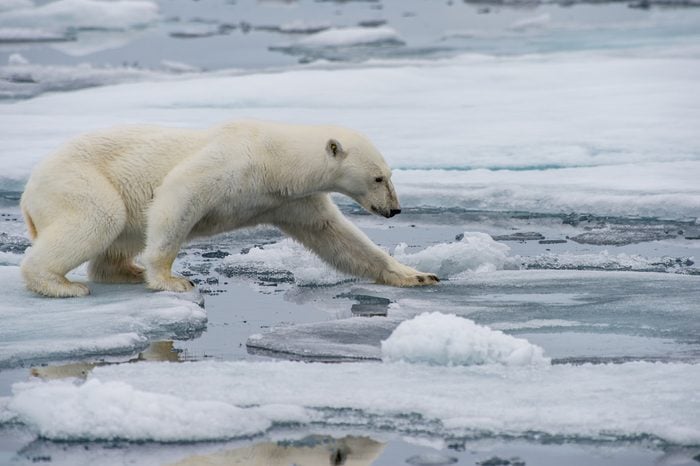
They’re as nimble on land as in the water
“Polar bears can walk several thousand miles a year,” Laidre says. Their huge paws have small bumps on the bottoms that grip the ice when they’re walking to keep them from slipping, and they have fur between their toes that also helps with traction, according to Polar Bears International. When they’re crossing thin ice, they walk with their feet spread far apart to distribute their weight more evenly and avoid breaking through.
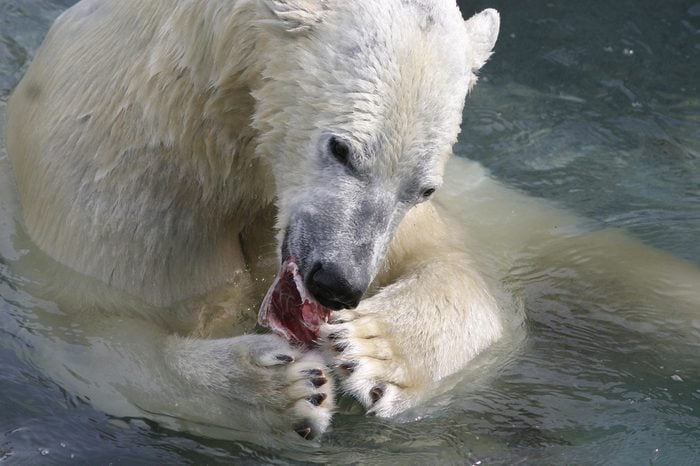
Polar bears are amazing hunters
Their favorite meal is a seal, which they catch with their claws. Those claws are fearsome—each measures almost two inches long, according to Polar Bears International. They sometimes sneak up on unsuspecting seals on the ice; other times they wait by a hole for seals to pop up for air. Although the bears are great swimmers, they’re no match for their primary prey. “Seals are too fast,” Regehr says. “They catch them on top of the sea ice or when seals are in under-ice dens that are covered in snow.” When there are plenty of seals to be had, polar bears don’t even bother eating the whole animal—they just eat the blubber, which is energy-rich and helps the bears build up their own layers of insulating fat. Check out these other 15 cute-but-deadly animals.
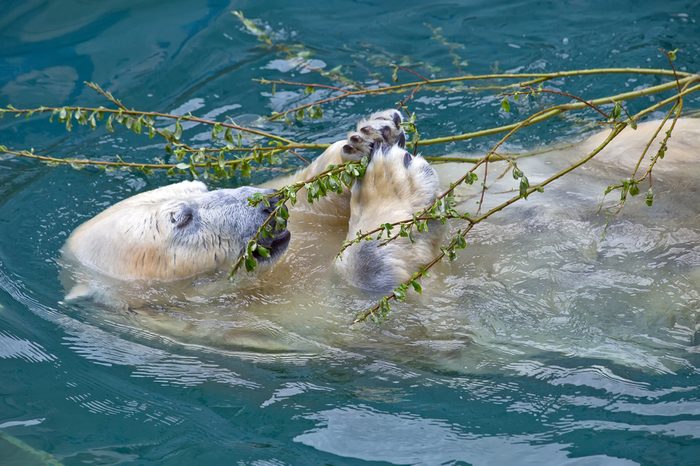
They will eat other things
They’re not their preference, but polar bears will eat bird eggs, small mammals, and sometimes even vegetation in a pinch, according to Polar Bears International. “Polar bears feed on small whales like belugas and narwhals, occasionally walrus, and if they find a large dead whale, they will scavenge on that too,” Laidre says.
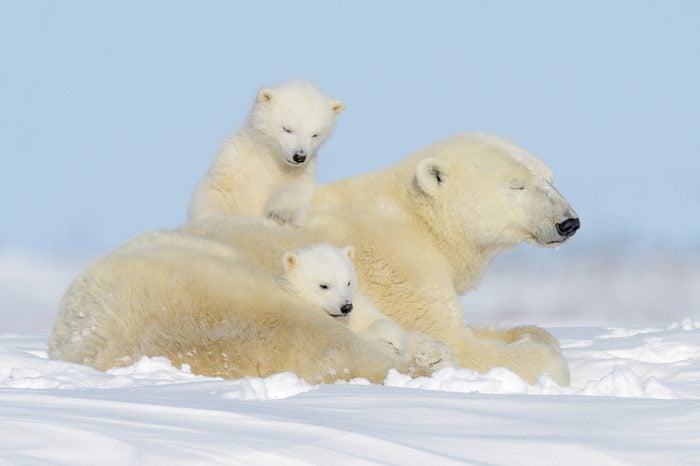
They can go months without food
“Polar bears feed when sea ice is available for hunting,” Laidre says. “That’s primarily from late fall until early summer. However, the feeding conditions are best in spring, when it’s light and there are fat seal pups.” During the off-season, polar bears mostly live off their own fat reserves. That’s especially true for mama bears. “Pregnant females go into maternity dens and do not eat for up to eight months in a row while they give birth and nurse their cubs,” she says. When they emerge from the maternity den, polar bear cubs stay with their mothers for about two and a half years, Laidre says. During that time, they learn to hunt and progressively reduce their nursing.
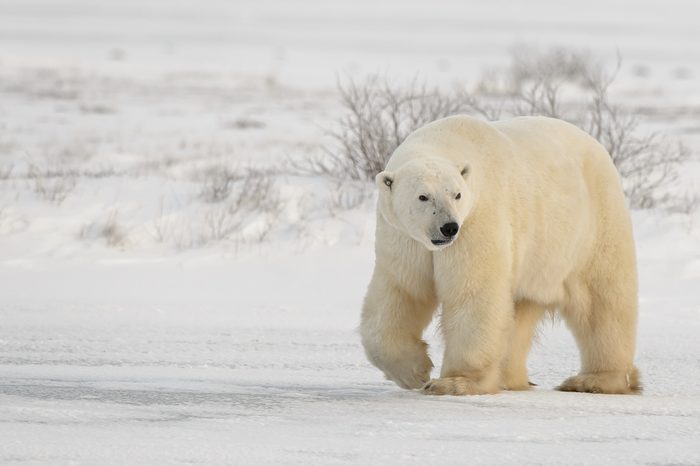
Polar bears are the largest four-legged carnivores
At birth, cubs weigh less than most human babies—a newborn polar bear weighs just over a pound, according to LiveScience. They grow quickly though. Fully grown female bears weigh between 330 and 650 pounds, but males can be much bigger: “A very large male bear can top 1,500 pounds,” Regehr says. “Some of the biggest polar bears in the world occur west of Alaska in the Chukchi Sea.” Learn the truth behind these 23 myths about animals you still believe.
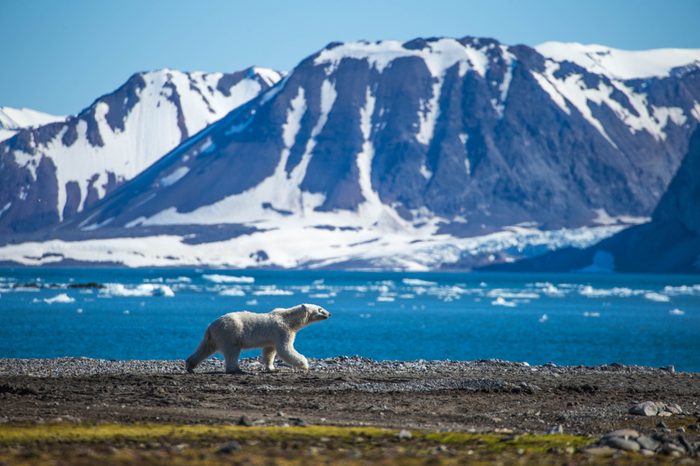
There are 19 subpopulations of polar bears
All types of polar bears live in the Arctic, including in Alaska, Canada, Greenland, Norway, and Russia, according to Polar Bears International. “The 19 subpopulations are defined by their movements and how genetically related they are to one another,” Laidre says. “The subpopulations vary in number and in how much area of the Arctic they take up.” Subpopulations of bears that live in areas with seasonal ice cover—meaning the sea ice disappears for a few months of the year—must stay on land and fast until the ice re-forms. Bears in areas with access to sea ice most of the year, like those in East Greenland, don’t have to go as long without food.
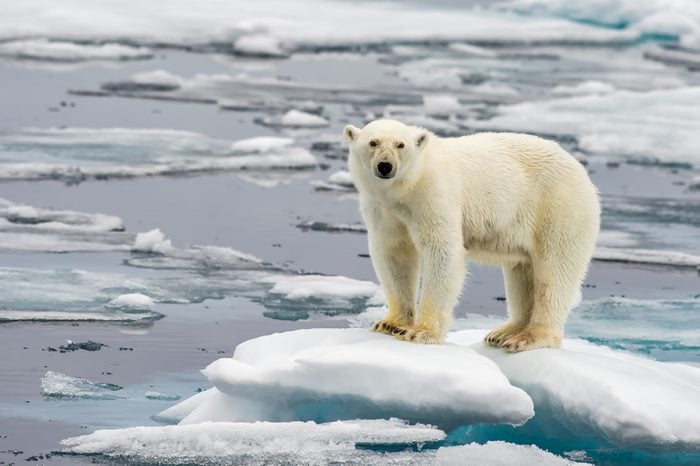
Climate change is a major threat to polar bears
The U.S. National Oceanic and Atmospheric Administration’s 2018 Arctic Report Card shows that polar sea ice coverage reached its second-lowest level on record last year. “Polar bears need sea ice, which is declining due to climate change,” Regehr says. “This has led to lower polar bear numbers in some areas.” He adds that in other areas, subpopulations have been holding steady, possibly because of good hunting opportunities. But the outlook isn’t good, according to a 2016 study in Biology Letters. “In the next few decades, the Arctic is predicted to have no sea ice in summer,” Regehr says. “This will likely lead to a decline in all subpopulations around the Arctic.” Read about 14 other beautiful animals that could go extinct during your lifetime.
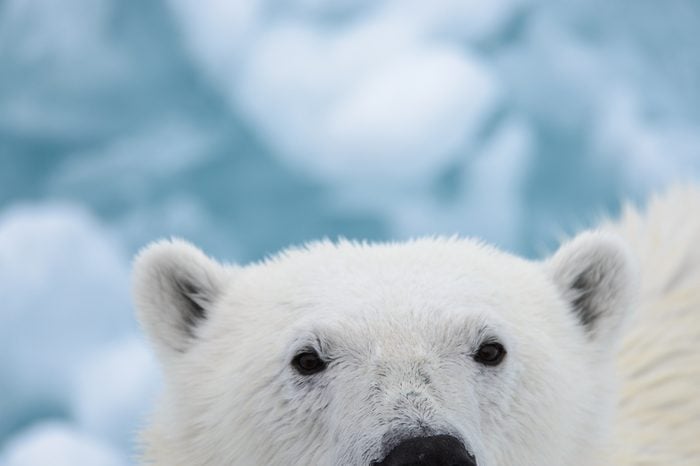
Humans and polar bears can get along
“Polar bears live in close proximity to northern communities and sometimes interact with humans on a daily basis,” Laidre says. The small town of Churchill, in Manitoba, Canada, for example, lies along the migration route of a group of bears—hundreds of them typically gather there in the summer while they wait for sea ice to form on Hudson Bay. According to an article in The Atlantic, residents call a polar bear hotline when they spot one wandering in town so that it can either be scared off or trapped. Nuisance bears are kept in a cage for up to a month without food, so they’ll get the hint that they should keep their distance, and then they are transported out of town. “Polar bears are predators, and they are smart and curious animals,” Laidre says. “They can be dangerous to anything they perceive as food. That said, they try to avoid humans and prefer to hunt their natural prey.” For more cold-climate animal facts, check out these 13 things you never knew about penguins.